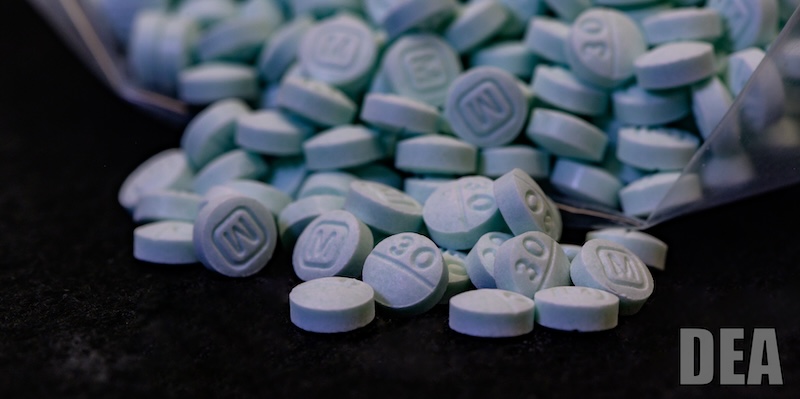What is the Drug Called “Blues?”
“Blues” are a specific type of counterfeit drug that has gained notoriety in recent times. These pills are particularly dangerous due to their composition and the effects they have on users.
Understanding the Blues Drug
“Blues” refers to counterfeit pills often laced with fentanyl, a synthetic opioid much stronger than heroin and morphine. These counterfeit prescription pills are made to resemble prescription opioids like oxycodone, also known by the brand name OxyContin, and pose a high risk of overdose due to their composition. Some common street names include:
- M30s
- Mexican oxy
- Percs (short for Percocet, which contains oxycodone)
- Roxies (short for Roxicodone, another brand name for oxycodone)
- Blues
- Blue footballs
- M boxes
- Blueberries
According to an article by the Federal Bureau of Investigation (FBI), the rise in these fake pills has contributed to a surge in overdose deaths. Fentanyl’s strength and modifications into even more potent substances, like carfentanil, exacerbate the issue. The increasing availability and lethality of counterfeit blues have become a significant concern for law enforcement and public health.

Contact Profound Treatment to Learn More
Our team is standing by to discuss treatment options with you. Your call is completely confidential and no obligation is required.
Understanding Fentanyl
Fentanyl is a powerful synthetic opioid that is similar to morphine but is 50 to 100 times more potent. It is a prescription drug that is also made and used illegally. Like morphine, it is a medicine typically used to treat patients with severe pain, especially after surgery, or those with chronic pain who are physically tolerant to other opioids.
Medical Uses of Fentanyl
- Pain management: Fentanyl is used in various forms, such as patches, lozenges, and injections, to manage severe pain.
- Anesthesia: It is often used as part of anesthesia to help prevent pain after surgery or other medical procedures.
Prescription and Illicit Drug Use
When prescribed by a professional or a provider, fentanyl can be administered safely and effectively. However, the majority of fentanyl-related harm, overdose, and death in the United States is linked to illegally made fentanyl. This illicit fentanyl is sold through illegal drug markets for its heroin-like effect. It is often mixed with heroin or cocaine as a combination product—with or without the user’s knowledge—to increase its euphoric effects.
Government and Public Concern About the Fentanyl Crisis
The rise in fentanyl-related overdoses has become a significant public health crisis. Government agencies and public health organizations have launched various campaigns to raise awareness and combat the spread of fentanyl.
- DEA’s One Pill Can Kill Campaign: The Drug Enforcement Administration (DEA) has initiated the “One Pill Can Kill” campaign to educate the public about the dangers of counterfeit pills containing fentanyl. The campaign emphasizes that even one counterfeit pill can be lethal and aims to reduce the availability and misuse of these drugs through enforcement actions and public education.
Overall, law enforcement agencies are actively involved in efforts to address the fentanyl crisis and curb its distribution and use, underlining the serious nature of offenses related to these potent and dangerous pills.
What Do “Blues” Look Like?
“Blues” pills, most frequently associated with counterfeit opioids, typically resemble legitimate prescription opioid pills such as oxycodone M30 tablets. These pills are small, round, and blue with an “M30” imprint, mirroring the look of natural oxycodone pills. However, they are illicitly produced and contain fentanyl, a highly potent synthetic opioid, making them extremely dangerous. Though most drug users know them well at this point, their appearance can deceive some into believing they are consuming actual M30 prescription pills, which are far less potent than fentanyl, leading to a heightened risk of overdose.
Contact Profound Treatment to Learn More
Our team is standing by to discuss treatment options with you. Your call is completely confidential and no obligation is required.
How Do Blues Pills Affect Users?
Upon ingestion of these blue counterfeit painkillers, users experience a rapid onset of euphoria and pain relief due to the powerful opioid effects of fentanyl. This can also be accompanied by sedation and a sense of relaxation. However, the side effects can be severe and dangerous.
Common Side Effects of “Blues”
- Drowsiness or sedation: Users may feel extremely tired or fall asleep unexpectedly.
- Nausea and vomiting: Fentanyl can cause significant gastrointestinal discomfort.
- Constipation: Opioids often lead to severe constipation, which can be painful and cause other digestive issues.
- Confusion: Cognitive impairment and confusion are common, making it difficult for users to think clearly.
- Dizziness: Users may experience dizziness, increasing the risk of falls and accidents.
- Respiratory depression: Fentanyl significantly slows breathing, which can be life-threatening.
- Itchiness: Users often feel an unexplained itch all over their bodies.
- Sweating: Excessive sweating can occur, even in colder environments.
The Dangers of Blue Fentanyl Pills
M30 pills are hazardous mainly because of fentanyl, which is far more potent than typical opioids. The presence of fentanyl leads to powerful euphoric effects but also dramatically increases the risk of overdose and serious health complications.
Another critical danger of these pills is the unpredictable amount of fentanyl each contains. This inconsistency means users cannot reliably gauge a safe dose, significantly heightening the risk of overdose, even among those with opioid tolerance.
Another critical danger of these pills is the unpredictable amount of fentanyl each contains. This inconsistency means users cannot reliably gauge a safe dose, significantly heightening the risk of overdose, even among those with opioid tolerance.

What to Do in the Event of an Overdose
If you suspect someone is experiencing an overdose, it is crucial to act quickly. Here are the steps to take:
- Call emergency services: Dial 911 immediately to get professional medical help.
- Administer naloxone (Narcan): If available, administer naloxone (Narcan) as it can temporarily reverse the effects of an opioid overdose. This can be given as a nasal spray or an injection.
- Stay with the person: Stay with the individual until emergency services arrive. Try to keep them awake and breathing.
- Follow emergency operator instructions: The emergency operator can provide instructions on what to do while waiting for the ambulance.
Using naloxone can save a life, but it is essential to seek emergency help right away to ensure the individual receives the necessary medical attention.
Effects of Long-Term Fentanyl Use
Long-term use of “blues” pills and opioids can lead to serious health issues like substance use disorder (SUD), tolerance, and withdrawal symptoms. Chronic use might result in:
- Addiction and dependency: An intense physical and psychological need to continue using the drug.
- Chronic respiratory problems: Long-term damage to the respiratory system, reducing lung capacity.
- Neurological damage: Persistent cognitive impairment, memory loss, and reduced executive functioning.
- Mental health disorders: Increased risk of developing conditions such as depression, anxiety, and psychosis.
- Physical health deterioration: Damage to vital organs like the liver, kidneys, and heart, leading to serious health complications.
The immediate and long-term effects of blues highlight the severe risks associated with these counterfeit pills, underscoring the importance of seeking professional help for substance abuse.
Signs Someone is Using “Blues”
If you’re concerned someone in your life might be using M30 pills, it can be helpful to look out for the following signs. Recognizing these indicators early can be crucial in providing the necessary help and intervention.
Behavioral and Physical Signs of Fentanyl Use
- Noticeable mood swings: Rapid and extreme changes in mood, including sudden bouts of euphoria followed by irritability or depression.
- Changes in behavior: Uncharacteristic actions such as increased secrecy, social withdrawal, or neglect of responsibilities.
- Drowsiness or sedation: Persistent fatigue or falling asleep at inappropriate times, such as during conversations or activities.
- Constricted pupils: Pinpoint pupils that do not respond to changes in light are a common sign of opioid use.
- Slowed breathing: Noticeably slow or labored breathing can be dangerous and potentially life-threatening.
Physical Symptoms of Fentanyl Use
- Nausea: Frequent complaints of nausea or episodes of vomiting.
- Unexplained itchiness: Persistent itching without a clear cause, often resulting in scratch marks on the skin.
- Unexplained weight loss: Significant weight loss without changing diet or exercise habits indicates potential neglect of nutrition.
- Neglect of personal hygiene: Deterioration in personal grooming and cleanliness, such as wearing dirty clothes or having an unkempt appearance.
- Altered sleep patterns: Irregular sleeping habits, including insomnia or excessive sleeping at odd hours.
Psychological and Withdrawal Symptoms
- Withdrawal symptoms when not using: Observable symptoms of withdrawal, including agitation, anxiety, muscle aches, sweating, and flu-like symptoms, when the individual is not using the drug. This is true of all opioids.
Note: These indicators, especially when combined, can suggest opioid use and warrant further attention or intervention. If you suspect someone is using blues pills, it is vital to approach the situation with care and seek professional help.
How Have Blues Pills Impacted the Opioid Epidemic?
The opioid crisis, a significant public health crisis, has been exacerbated by the emergence of “blues” pills. These pills contribute to the high rates of opioid addiction and overdose deaths due to their potency and deceptive appearance, which resembles prescription medication. The availability and misuse of “blues” highlight the ongoing challenges in addressing the broader opioid epidemic, emphasizing the need for public awareness, effective treatment options and strategies, and law enforcement efforts to combat this crisis.

How to Detox from “Blues” Pills
If you or someone you know is struggling with addiction to “blues,” seeking professional help immediately is extremely important. Detoxing from fentanyl can be highly challenging and dangerous without medical supervision due to the potency and risk of severe withdrawal symptoms. Here’s what you need to know about getting help for fentanyl addiction and the detox process:
The Importance of Professional Help When Quitting Opioids
- Medical supervision: Detoxing from fentanyl and other opioids can cause intense withdrawal symptoms, including severe cravings, anxiety, muscle pain, insomnia, nausea, and potential complications such as respiratory distress. Medical supervision ensures that these symptoms are managed safely.
- Support and safety: In a professional setting, individuals receive continuous support, monitoring, and interventions to manage withdrawal symptoms and prevent complications. This increases the likelihood of a successful detox.
- Medication-Assisted Treatment (MAT): MAT involves using FDA-approved medications like buprenorphine, methadone, or naltrexone to ease withdrawal symptoms and reduce cravings. This approach is highly effective in helping individuals safely detox from opioids.
Profound Treatment's Approach to Fentanyl Detox & Treatment
At Profound Treatment, located in Woodland Hills, CA, we offer comprehensive inpatient opioid detox programs specifically designed for those struggling with addiction to fentanyl and related substances like “blues.” Our approach includes:
- Individualized treatment plans: We understand that each person’s experience with drug abuse is unique. Our team creates personalized treatment plans tailored to individual needs, ensuring effective care.
- Medically-supervised detox: To ensure minimal discomfort during the withdrawal process, we use MAT to manage withdrawal symptoms and cravings. This helps individuals detox safely and comfortably.
- Experienced team: Our skilled medical professionals, therapists, and support staff are dedicated to providing compassionate care. We prioritize creating a safe and supportive environment for our clients.
- Holistic support: In addition to detoxification, we offer holistic support services, including counseling, therapy, and wellness programs, to address the underlying causes of addiction and promote long-term recovery and well-being.
Recovery from addiction is a challenging but achievable journey. By seeking professional help at Profound Treatment Center, individuals can take the first crucial step toward overcoming their addiction. Our comprehensive treatment programs and supportive environment help individuals detox and build a strong foundation for a healthier, substance-free life.
Learn More About Fentanyl Addiction Treatment at Profound in Woodland Hills.

Begin Your Profound Healing Journey in Woodland Hills
We offer a unique and compassionate approach to addiction at Profound Treatment, located in Woodland Hills, CA. Our experienced team understands the complexities of drug addiction, including emerging trends like the blues drug.
If you or a loved one is struggling with addiction, reach out to Profound Treatment for expert care and support.
Our admissions team will contact your insurance company to personally verify your individual health care plan coverage and connect you to the care you need.
References
1. FBI. (n.d.). The fatal blues. FBI Law Enforcement Bulletin. Accessed from https://leb.fbi.gov/articles/featured-articles/the-fatal-blues
2. Ramos-Matos CF, Bistas KG, Lopez-Ojeda W. Fentanyl. [Updated 2023 May 29]. In: StatPearls [Internet]. Treasure Island (FL): StatPearls Publishing; 2024 Jan-. Accessed from: https://www.ncbi.nlm.nih.gov/books/NBK459275/.
3. Han, Y., Yan, W., Zheng, Y., Khan, M. Z., Yuan, K., & Lu, L. (2019). The rising crisis of illicit fentanyl use, overdose, and potential therapeutic strategies. Translational psychiatry, 9(1), 282. https://doi.org/10.1038/s41398-019-0625-0. Accessed from:
4. Centers for Disease Control and Prevention. (2018). Drug overdose deaths. CDC Archive. Retrieved from https://archive.cdc.gov/#/details?q=overdose%20deaths&start=0&rows=10&url=https://www.cdc.gov/media/releases/2018/p0329-drug-overdose-deaths.html
5. Centers for Disease Control and Prevention. (n.d.). Understanding the opioid overdose epidemic. CDC. Retrieved from https://www.cdc.gov/overdose-prevention/about/understanding-the-opioid-overdose-epidemic.html?CDC_AAref_Val=https://www.cdc.gov/opioids/basics/epidemic.html
6. Drug Enforcement Administration. (n.d.). One pill can kill. DEA. Retrieved from https://www.dea.gov/onepill
Useful Links
Licensed by the State Department of Health Care Services.
Profound Healing Centers License No: 191092BP Exp. 5/31/26 (current/active)
Profound Healing Centers License No: 191092AP Exp. 7/31/25 (current/active)
Profound Treatment License No: 191047CP Exp. 1/31/27 (current/active)
Profound Treatment License No: 191047AP Exp. 8/31/26 (current/active)
Profound Treatment License No: 191047EP Exp: 3/31/26 (current/active)
Profound Treatment License No: 191047DP Exp. 9/30/25 (current/active)
Click here for more information about DHCS licensing.
| Start your healing today>> | |
|---|---|
| (310) 929-9546 |








